
Diamond Rock is a 175-metre-high (574 ft) basalt island located south of "Grande Anse du Diamant" before arriving from the south at Fort-de-France, the main port of the Caribbean island of Martinique. The uninhabited island is about 3 kilometres (1.9 mi) from Pointe Diamant.

The British expedition against Guadeloupe was a military action from January to May 1759, as part of the Seven Years' War. A large British force had arrived in the West Indies, intending to seize French possessions. After a six-month-long battle to capture Guadeloupe they finally received the formal surrender of the island, just days before a large French relief force arrived under Admiral Maximin de Bompart.
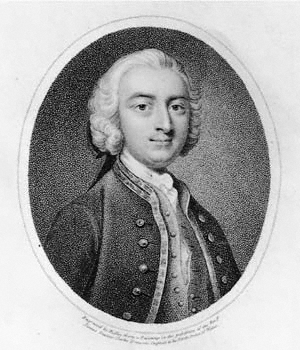
Admiral Sir John Moore, 1st Baronet, KB was a British officer of the Royal Navy during the War of the Austrian Succession and the Seven Years' War. He eventually rose to the rank of admiral.
HMS Boyne was a 70-gun third rate ship of the line of the Royal Navy, built at Plymouth Dockyard to the draught specified in the 1745 Establishment as amended in 1754, and launched on 31 May 1766. She was first commissioned for the Falkland Crisis of 1770 after which, in 1774, she sailed for North America. From March 1776, she served in the English Channel then, in May 1778, she was sent to the West Indies where she took part in the battles of St Lucia, Grenada and Martinique. In November 1780, Boyne returned home, where she was fitted for ordinary at Plymouth. In May 1783, she was broken up.

The invasion of Martinique was a successful British amphibious operation against the French colony of Martinique that took place between 30 January and 24 February 1809 during the West Indies campaign of 1804–1810 of the Napoleonic Wars. Martinique, like the nearby island of Guadeloupe, was a major threat to Britain's trade in the West Indies, providing a sheltered base from which privateers and French Navy warships could raid British merchant shipping and disrupt the trade routes that maintained the economy of the United Kingdom. Both islands also provided a focus for larger-scale French operations in the region and in the autumn of 1808, following the Spanish alliance with Britain, the Admiralty decided to order a British squadron to neutralise the threat, beginning with Martinique.
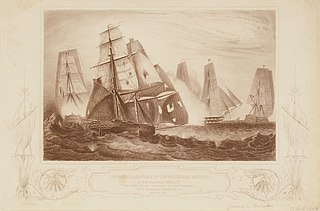
Troude's expedition to the Caribbean was a naval operation by a French force under Commodore Amable-Gilles Troude during the Napoleonic Wars. The French squadron departed from Lorient in February 1809 in an attempt to reach and resupply the island colony of Martinique in the Caribbean Sea, then under invasion from a British expeditionary force. The force arrived much too late to affect the outcome of the successful invasion and took shelter from a British squadron in the Îles des Saintes, where they were blockaded by part of the British invasion fleet, led by Vice-Admiral Sir Alexander Cochrane. Two weeks after the French ships arrived, British troops invaded and captured the Saintes, constructing mortar batteries to bombard the French squadron. With his position unsustainable, Commodore Troude decided to break out.
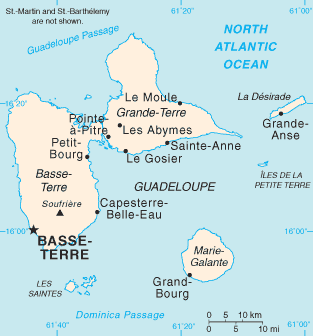
The action of 22 January 1809 was a minor naval engagement fought off the Caribbean island of Guadeloupe during the Napoleonic Wars. The action was fought as part of the blockade of Guadeloupe and neighbouring Martinique by a large British Royal Navy squadron, which was seeking to cut the islands off from contact and supplies from France by preventing the passage of shipping from Europe to the islands. The British blockade was part of their preparation for planned invasions during the next year.


Roquebert's expedition to the Caribbean, was an unsuccessful operation by a French naval squadron to transport supplies to Guadeloupe in December 1809 at the height of the Napoleonic Wars. Over the previous year, British Royal Navy squadrons had isolated and defeated the French Caribbean colonies one by one, until by the autumn Guadeloupe was the only colony remaining in French hands. Cut off from the rest of the world by British blockade squadrons that intercepted all ships coming to or from the island, Guadeloupe was in a desperate situation, facing economic collapse, food shortages and social upheaval, as well as the impending threat of British invasion. In an effort to reinforce and resupply the colony, the French government sent four vessels to the West Indies in November 1809 under Commodore François Roquebert. Two of the ships were 20-gun flûtes carrying supplies and troops. The two others were 40-gun frigates, ordered to protect the storeships on their journey from the British forces operating off both the French and Guadeloupe coasts.
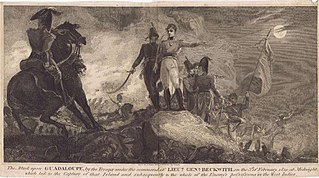
The Invasion of Guadeloupe was a British amphibious operation fought between 28 January and 6 February 1810 over control of the Caribbean island of Guadeloupe during the Napoleonic Wars. The island was the final remaining French colony in the Americas, following the systematic invasion and capture of the others during 1809 by British forces. During the Napoleonic Wars, the French colonies had provided protected harbours for French privateers and warships, which could prey on the numerous British trade routes in the Caribbean and then return to the colonies before British warships could react. In response, the British instituted a blockade of the islands, stationing ships off every port and seizing any vessel that tried to enter or leave. With trade and communication made dangerous by the British blockade squadrons, the economies and morale of the French colonies began to collapse, and in the summer of 1808 desperate messages were sent to France requesting help.

The Battle of Saint-Louis-du-Sud, also known as the Battle of Port Louis, was a battle fought in the Austrian War of Succession on 22 March 1748 in the French Caribbean colony of Saint Domingue. A British squadron under the command of Admiral Charles Knowles attacked and destroyed a large French fort under command of French governor Étienne Cochard de Chastenoye.

HMSEmerald was a 36-gun Amazon-class fifth rate frigate that Sir William Rule designed in 1794 for the Royal Navy. The Admiralty ordered her construction towards the end of May 1794 and work began the following month at Northfleet dockyard. She was completed on 12 October 1795 and joined Admiral John Jervis's fleet in the Mediterranean.
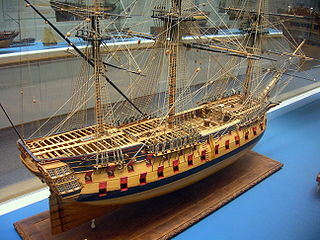
The action of 17 July 1761 was a naval engagement fought off the Spanish port of Cádiz between a British Royal Navy squadron and a smaller French Navy squadron during the Seven Years' War. British fleets had achieved dominance in European waters over the French following heavy defeats of French fleets in 1759. To maintain this control, British battle squadrons were stationed off French ports, as well as ports in neutral but French-supporting Spain which sheltered French warships. In 1761, two French ships, the 64-gun ship of the line Achille and 32-gun frigate Bouffone were blockaded in the principal Spanish naval base of Cádiz, on the Southern Atlantic coast of Spain.
The Battle of Guadeloupe or the Action of 21–22 December 1779 was a naval engagement that took place off the French island of Guadeloupe in the Caribbean during the American Revolutionary War between three Royal Navy ships and three French Navy frigates. The Royal Navy under Joshua Rowley sighted and promptly chased the French frigates, all of which were captured after a brief fight.
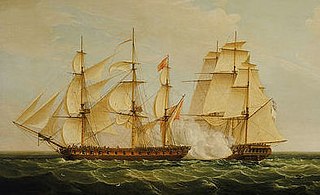
HMS Pearl was a fifth-rate, 32-gun British Royal Navy frigate of the Niger-class. Launched at Chatham Dockyard in 1762, she served in British North America until January 1773, when she sailed to England for repairs. Returning to North America in March 1776, to fight in the American Revolutionary War, Pearl escorted the transports which landed troops in Kip's Bay that September. Much of the following year was spent on the Delaware River where she took part in the Battle of Red Bank in October. Towards the end of 1777, Pearl joined Vice-Admiral Richard Howe's fleet in Narragansett Bay and was still there when the French fleet arrived and began an attack on British positions. Both fleets were forced to retire due to bad weather and the action was inconclusive. Pearl was then despatched to keep an eye on the French fleet, which had been driven into Boston.
HMS Roebuck was a 44-gun, fifth-rate sailing warship of the Royal Navy which carried a main battery of twenty 18-pounder (8.2 kg) long guns. Launched on 21 December 1743, she first served in the English Channel during the War of the Austrian Succession, which Britain entered the following March.

HMS Roebuck was a fifth-rate ship of the Royal Navy which served in the American and French Revolutionary Wars. Designed in 1769 by Sir Thomas Slade to operate in the shallower waters of North America, she joined Lord Howe's squadron towards the end of 1775 and took part in operations against New York the following year. She engaged the American gun batteries at Red Hook during the Battle of Long Island in August 1776, and forced a passage up the Hudson River in October. On 25 August 1777, Roebuck escorted troopships to Turkey Point, Maryland, where an army was landed for an assault on Philadelphia. She was again called upon to accompany troopships in December 1779, this time for an attack on Charleston. When the ships-of-the-line, which were too large to enter the harbour, were sent back to New York, Admiral Marriot Arbuthnot made Roebuck his flagship. She was, therefore, at the front of the attack, leading the British squadron across the shoal to engage Fort Moultrie and the American ships beyond.

Captain Jonas Rose was a Royal Navy officer during the American Revolutionary, French Revolutionary and Napoleonic Wars. He commanded at the Battles of Copenhagen in 1801 and 1807, and the operations in the Baltic that followed. On 16 June 1809, he wrecked his ship, HMS Agamemnon, off Maldonado, Uruguay, the second such accident of his career. He never commanded again and died in Portsmouth in 1820.
Samuel Campbell Rowley was a politician and Royal Navy officer who was born in Ireland in 1774. Rowley attended the Royal Naval Academy at Portsmouth in 1785 and joined his first ship in March 1789, serving in the West Indies. He passed the lieutenant's examination in 1792 but was not promoted until January 1794, when he joined HMS Vengeance. In her, Rowley took part in the West Indies campaign under Sir John Jervis and Sir Charles Grey, and was present at the capture of Martinique, St Lucia and Guadeloupe. Rowley returned to England at the beginning of 1795 and shortly after, was appointed to the 32-gun HMS Astraea, serving in the English Channel, where, on 10 April 1795, he assisted in the taking of the French 42-gun frigate, Gloire.
The British campaign in the Caribbean took place during the first year of the Napoleonic Wars and began shortly after the breakdown of the Treaty of Amiens. Hostilities with France resumed in May 1803 but official notification did not arrive in the West Indies until mid-June, along with British orders to attack France's valuable sugar islands. The expedition, under commanders in chief William Grinfield and Samuel Hood, set out from Barbados on 20 June with 3,149 soldiers, two ships-of-the-line, two frigates, converted to troopships, and two sloops. St Lucia was captured on 22 June 1803, after the island's main fortress, Morne Fortunee had been stormed, and Tobago nine days later. After leaving men to hold these islands, the expedition returned to Barbados.














